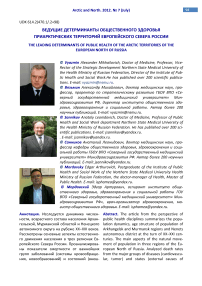The leading determinants of public health of the Arctic territories of the European North of Russia
Автор: Vyazmin A M., Sannikov A.L., Mordovsky E.A.
Журнал: Arctic and North @arctic-and-north
Рубрика: Sociological sciences
Статья в выпуске: 7, 2012 года.
Бесплатный доступ
The article from the perspective of public health disciplines summarizes the population dynamics, age structure of population of Arkhangelsk and Murmansk regions and Nenets autonomous district at the turn of XX−XXI centuries. The main aspects of the natural movement of population in three regions of the European North of Russia. Analyzed death rates from the major groups of diseases (cardiovascular, tumor) and states (external causes of death). The characteristics of the processes of marriage and divorce. The data on disability populations of the Arctic regions as one of the most important factors leading to a reduction of the labor potential.
Arctic, North, birth, death, marriages, divorces, disability
Короткий адрес: https://sciup.org/148320429
IDR: 148320429 | УДК: 614.2(470.1/.2+98)
Текст научной статьи The leading determinants of public health of the Arctic territories of the European North of Russia
At the turn of the XX--‐XXI centuries before the countries bordering the Arctic Ocean, faced the task of mastering the enormous resource potential of the region. Circumpolar area of the pe--‐ ripheral, a few decades ago, representing more than a scientific point of view, are now becoming a battleground. Economic effect of the Arctic, estimated by experts at 30 trillion dollars, began to prevail in the minds of management of polar countries over the real threat, which belongs to this process [1]. Environmental and climate problems, uncomfortable living conditions in the North, conditional reduction potential in life people take a back seat to geo--‐strategic advantages that will extraction of natural resources in this region of the planet.
The development of the Arctic territories requires large numbers of professionals and civil--‐ ians. In the Soviet Union policies to stimulate migration to the northern regions consistently im--‐ plemented for decades, which contributed, on the one hand, the radical change in the ethnic composition of the traditional inhabitants of the Arctic, on the other --‐ has caused the unique de--‐ mographics of the region.
General characteristics of the number of population and the age structure of the population in the Circumpolar regions of the Europaen North of Russia
Three regions of the European part of Russia (except for the Republic of Karelia) have ac--‐ cess to the waters of the Arctic Ocean: the Arkhangelsk and Murmansk, and the NAO. Arkhangelsk region occupies a special position on the list. Most of its territory lies south of the other two re--‐ gions. At the same time just for her example we can determine the degree of influence of the harsh climatic conditions on the health of the population, on the one hand, not belonging to a group of indigenous peoples of the North, on the other --‐ historically resident at high latitudes.
The demographic situation in the circumpolar areas of the country at the turn of XX--‐XXI centuries, according to UN experts, is "unstable"[2]. The reason is the "inequality of arctic and subarctic regions of the country in terms of socio--‐economic development, which is due ... to the presence in their territory of hydrocarbon raw materials and other resources"[2]. European North of Russia in this respect is in a unique situation because on the one hand, oil has long conducted a significant amount only in the NAO, on the other hand, the region is quite promising in the socio--‐ economic, transport and organically connected with wide network of economic ties with central
Russia.
Table 1
The number of population of circumpolar regions of European North of Russia [9]
|
1992 |
1995 |
1998 |
2001 |
2004 |
2007 |
2010 |
Dynam--‐ ics 1992 2010 |
|
|
Arkhan--‐ |
||||||||
|
gelsk |
1554584 |
1498182 |
1433874 |
1396118 |
1317923 |
1280187 |
1254449 |
--‐19,3 |
|
region |
||||||||
|
NAO |
50245 |
44526 |
41774 |
40931 |
41832 |
41960 |
42293 |
--‐15,8 |
|
Mur--‐ |
||||||||
|
mansk |
1170371 |
1066924 |
987936 |
922875 |
880003 |
856969 |
836672 |
--‐28,5 |
|
region |
From the data (Table 1) shows that for 20 years of the modern history of Russia's popula--‐ tion of Arctic regions of the European part of it fell by an average of 1/5. During the same period in the whole country, it decreased by only 3.9%. With the exception of the NAO, in recent years, the negative dynamics in the value of this indicator is static population in other regions remains. This discrepancy can be explained by many factors, the most important of which are the mass exodus of people of retirement age and working in the middle lane and the deterioration of access to health care due to reduction in the number of doctors and hospitals [2].
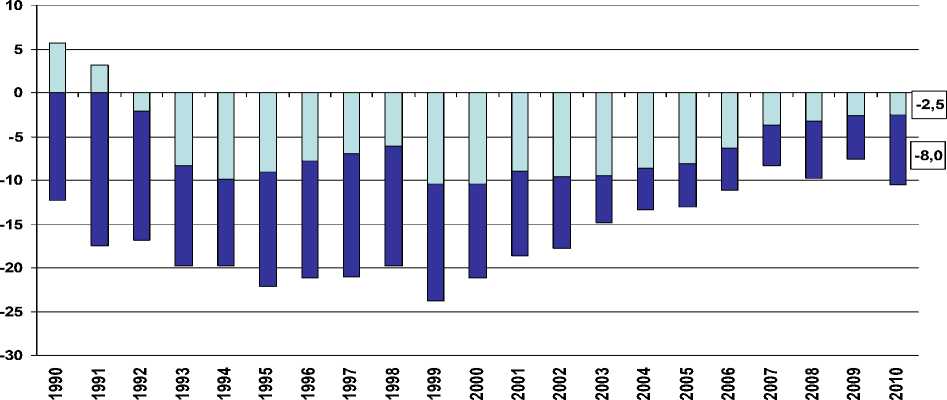
I □ естественный прирост■ миграционный прирост
Picture 1. Components of population decline in the Arkhangelsk region in1990-2010 thousands of people [4]
Migration factor determines the scale of today depopulation process in the North--‐West Federal District as a whole and in the circumpolar regions of the Northern European countries in particular. In the Arkhangelsk region in 2006, leading it has overtaken the natural decline in popu--‐ lation, and in 2010 led to four fifths of the population loss in the region (Figure 1). Unfortunately, the population projections of the Federal District and the region in the run up to 2025--‐2030 peri--‐ ods remain negative. The pessimistic version of the forecast in the next 15--‐20 years the population here may be reduced by a quarter. [3] Murmansk Region will lose more than 200 thousand people, the Arkhangelsk region --‐ from 100 to 125 thousand people [3,9].
Population The migrational turnover of the population of the Arkhangelsk region has its own characteristics. Reasons of the personal and family accounts for more than half of the dis--‐ placed (51.7% of the number of arrivals and 58.4% of those departing in 2005). The work is the reason for a change of the residence for 13.8% of all migrants. Forced migration as a phenomenon in the beginning of XXI century, was not characteristic of the region. This is explained by the severe climatic conditions and the characteristics of the local economy [3].
At the turn of the XX--‐XXI centuries one of the most important factors in determining the reduction in the labor potential of European circumpolar regions of Russia, is the aging of the pop--‐ ulation. Each year, the proportion of people of retirement age is increased (Figure 2).
20,6
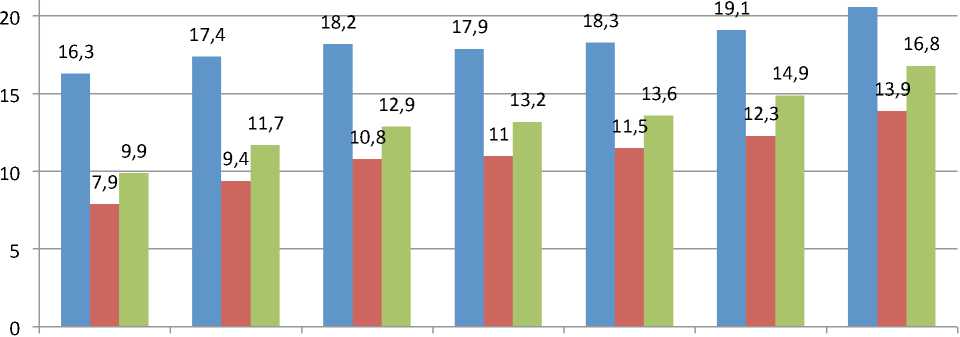
1992 1995 1998 2001 2004 2007 2010
■ Архангельская область ■ Ненецкий автономный округ ■ Мурманская область
-
Figure 2. The percentage of the population in the circumpolar regions of the European North of Russia over working age, % [9]
Three regions of the European North of Russia, bordering the Arctic Ocean (with the excep--‐ tion of the Republic of Karelia) in regard to the dynamics of this indicator are divided into two het--‐ erogeneous groups. On the one hand --‐ the Arkhangelsk region in which the absolute number of people of retirement age in 20 years of modern history has not changed (253 372 people in 1992 and 258 719 in 2010), and the increase in the share of this group of people in the total population due population decline in the group under the working age [9], on the other --‐ Murmansk and the NAO, where the absolute number of working age population increased by 1/5 and 1/2, respective--‐ ly (116,191 in 1992 and 140,346 people in 2010 in the Murmansk region, 3 986 people in 1992 and 5,883 people in 2010, the NAO)[9]. There is a paradox: the population in the age group over 60 is retired to live in a more adverse climatic regions not take the opportunity to move into the central zone of the country, though it is compared with the inhabitants of the Arkhangelsk region more social benefits and high returns.
In this connection it is interesting to analyze the status of such an important indicator of population health, life expectancy [12]. This indicator is an indirect indication of the socio--‐ economic well--‐being of the population and the effectiveness of the health of the region (Figure 3).
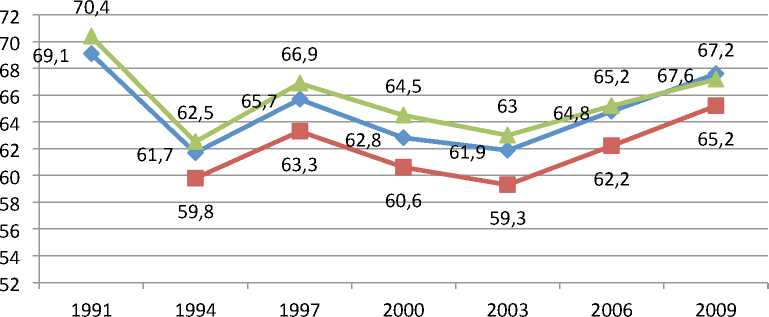
Архангельская область — ■ -Ненецкий автономный район
-*- Мурманская область
-
Figure 3. Expectancy of the population of circumpolar regions of the European North of Russia, both sexes, in the years [9]
If the national average value of the indicator (for men and women) did not change (68.9 years in 1991 and 68.7 years in 2009), in the Arctic regions of the European part of Russia, it has decreased. [9] Particularly sharp, life expectancy fell between 1991 and 1994 (an average of al--‐ most 7 years). From 1994 to 2003, inclusive, dynamic figure remained unstable, and only since 2004 in all three regions of the gradual increase of its value. But even today, the life expectancy of the population remains below the pre--‐crisis. An example of the Arkhangelsk region in this case is also revealing. In comparison with the Murmansk region, where the life expectancy of men and women in the study period is the average time was always higher in the Arkhangelsk region of rel--‐ atively more favorable climatic factors have not been able to "outweigh" in its influence quality of life of the local population (especially if to take into account that the fact that the absolute growth of the working age population is not observed). In other words, in its influence on population health climatic factors Arctic territories are significantly inferior in strength of social and economic.
Continues to increase the average age of the circumpolar areas of the European part of Russia. During the first decade of the XXI century in the Arkhangelsk region, it rose almost 2 years (36.5 years in 2001 and 38.3 years in 2010). The average age of women with more than 5 years than identical for males (40.7 and 35.5 years, respectively) [4].
The natural movement of the population in the circumpolar territories of the European North of Russia
The demographic situation in the beginning of the XXI century in Russia remains difficult. It is the logical result of the severe social turmoil that the country has experienced in the first half of the XX century, the result of the total for developed countries the demographic transition, social and economic upheavals of the 1990s, as well as changes in the culture of reproductive behavior.
|
20 15 |
14,7 |
13,7 |
13,6 |
14,6 |
14,2 |
15,6 |
16,4 12,6 |
|
10,4 |
8,9 |
9,1 |
9,6 |
11 |
11,9 |
||
|
10 |
8,3 |
8,2 |
8,4 |
9,1 |
10,2 |
10,3 |
11,7 |
|
5 |
|||||||
|
0 |
1992 |
1995 |
1998 |
2001 |
2004 |
2007 |
2010 |
|
Архангельская область - ■ -Ненецкий автономный округ |
Мурманская область |
||||||
Figure 4. The Number of births per 1000 population per year in the circumpolar regions of the European North of Russia [9]
The European North, these processes have their own characteristics. For absolute values and dynamics fertility Arctic regions can be divided into two groups (Figure 4). On the one hand --‐ Arkhangelsk and Murmansk regions, in which the demographic situation is virtually identical to the general trends in the country. In 1965, the total fertility rate in the USSR fell below replacement level of generations (2.15). In conjunction with the social and economic upheavals of the 1990s, an unprecedented high mortality rate among working--‐age is caused relatively low total fertility, which are stored in the Circumpolar. On the other hand – is the NAO. The total fertility rate of Indigenous Peoples of the North, though steadily declined in the second half of the XXI century, always re--‐ mained well above the national average: 2.2 vs. 1.3. [2] For Nenets, in particular, the figure is 3.1 [2]. For this reason, the total birth rate in the area was and remains much higher than in the Ar--‐ khangelsk and Murmansk regions (Figure 4).
Beginning in 2000 in the Arkhangelsk region there is a tendency to an increase in fertility. To a large extent, this phenomenon is due to the achievements of women and men in the 1980s birth of reproductive age. Positively influenced by the national project "Health", the implementa--‐ tion of which will help to stimulate the birth rate in the middle age cohorts of women (25--‐29 years, 30--‐34 years, 35--‐39 years)[4]. In the analysis of the described phenomenon is taken into ac--‐ count and the fact that the average in Russia at the beginning of XXI century the number of wom--‐ en of childbearing age exceed by more than 1 million to that for 1989. It is likely to expect to 2020--‐ 2025, a new slowdown in the dynamics or, more likely, even its significant reduction, when the birth of the "failing" from a demographic point of view, 1990 will reach its reproductive life. Will have a negative impact and a growing level of female infertility, which over the last 10 years has increased more than 3 times (from 2,3 ‰ for women of reproductive age in 2001 to 7,2 ‰ in 2010). In 2010, the region was born 15 466 children, and the birth rate was 12.6 per 1 000 popula--‐ tion. [4] But even reach the level of 1990 in the value of the indicator (13.5 per 1000) has not yet succeeded. Among the rural population at the beginning of 2010, the total fertility rate is 2.09, and for the cities --‐ 1.39 (average 1.53 births per woman of reproductive age 1). By 2030, according to forecasts, the value can reach 1.66 [4]. Reverse the situation can only change people's reproduc--‐ tive behavior of the Arkhangelsk region, which is quite difficult, if you take into account the prob--‐ lem of poor quality of sexual self--‐preserving behavior of the northerners [3].
Abortion at the turn of XX--‐XXI centuries the people of the region to the predominant mode of regulation of family size. The number of abortions in Russia in the same year was 92, in the Ar--‐ khangelsk region --‐ 127. In the regional center in 1996, the proportion of abortions performed per 100 births was 254.6 in 2005 --‐ 356.1 [3]. Thus, in the middle of the first decade of the XXI century, the capital of the Russian North at every birth had an average of 3.5 abortions. Even more danger--‐ ous is the tendency to increase the relative number of young women to terminate a pregnancy (at age 20), from 1.9% in 1986 to 11.1% in 2005 [3]. We can assume that in the near future, the region expects a significant increase in the prevalence of secondary infertility, which will further exacer--‐ bate the severity of health and social consequences of the problem.
Mortality in the circumpolar regions of the European part of Russia also has its own charac--‐ teristics. On its scale affected by a number of factors. On the one hand, it is logical to assume that the migration of the population in the group of retirement age should generally reduce the overall mortality rate.
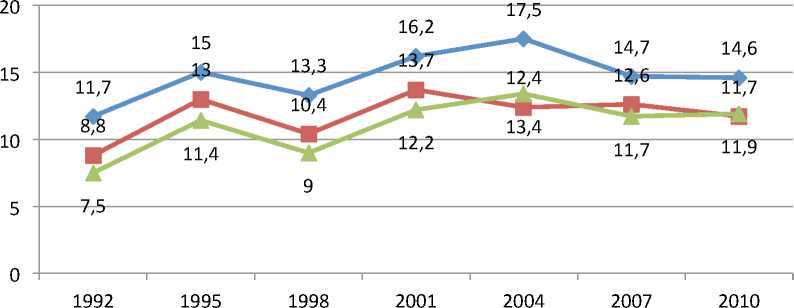
Архангельская область — ■ -Ненецкий автономный округ
—*- Мурманская область
Figure 5. The number of deaths per 1000 population per year in the circumpolar regions European North of Russia, both sexes [9]
This relationship can be seen in the Murmansk region and the NAO, where he was the val--‐ ue is much lower compared with the Arkhangelsk region up to 1992 (Figure 5). In the following years, as internal migration in the first two regions declined in comparison with the Soviet period, the overall mortality rate was closer to the average values.
At the beginning of XXI century for the Circumpolar regions remains an urgent problem of high mortality of the male population of working age (Figure 6).

■ Мужчины ■ Женщины
Figure 6. Mortality in depence on sex in the working age
(at 1 000 corresponding sex and age) in the circumpolar regions of the European part of Russia in 2008 [9
Living in the harsh conditons of the Arctic climate and maintenance work jobs require con--‐ siderable stamina. The specific form of chronic polar tension, low resistance, characteristic for the northerners, lead to early depletion of the body's reserves, increased morbidity and premature aging [2]. However, these factors only partially explain the differences in the value of the mortality rate of the male population of working age in the three regions. In the NAO, in particular, it is 1.5 times higher than the national average. This situation is due to several reasons, the leading of which are extra high mortality rate among working--‐age Nenets as one of the indigenous peoples of the North and a significant level of mortality from external causes (see below). In the Murmansk region, on the contrary, the problem is less significant.
The structure of mortality Arctic regions also has significant differences. The process of de--‐ population is associated mainly with high mortality from diseases of the circulatory system. Ar--‐ khangelsk region in this regard is almost exactly the average trend indicator (Figure 7). On the oth--‐ er hand, in the Murmansk region and the NAO mortality from this group of causes at the turn of XX--‐XXI centuries remains relatively low. For the latter region, this situation is understandable. Until recently, the incidence of hypertensive heart disease, coronary heart disease and obesity among the small peoples of the Russian North was at a low level [2].
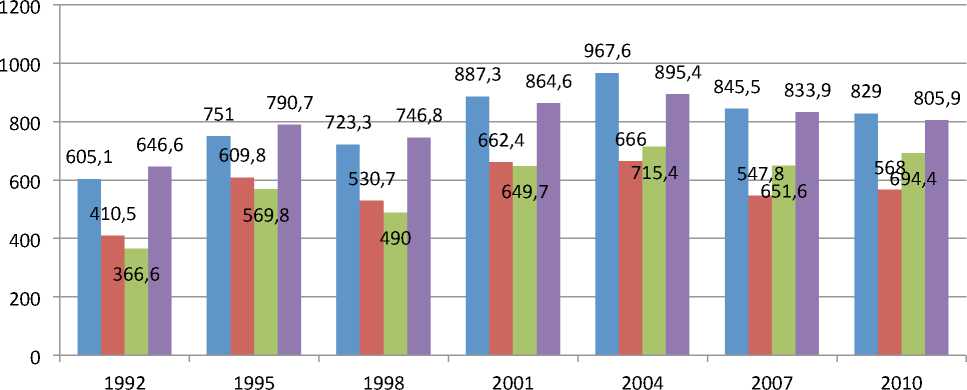
■ Архангельская область ■ Ненецкий автономный округ
■ Мурманская область ■ Российская Федерация
Figure 7. The number of deaths from circulatory diseases per 100 thousand people a year in the circumpolar regions of the European North of Russia, both sexes [9
The traditional way of life Sami, Nenets, Yakuts and other northern peoples to diet, physi--‐ cal activity is healthy enough, potentially predisposing to a longer life, a lower incidence of socially significant diseases. Only the process of gradual withdrawal to a sedentary lifestyle and diet changes, efforts to turn XX--‐XXI centuries, led to the disappearance of such differences with the non--‐indigenous population [2, 14].
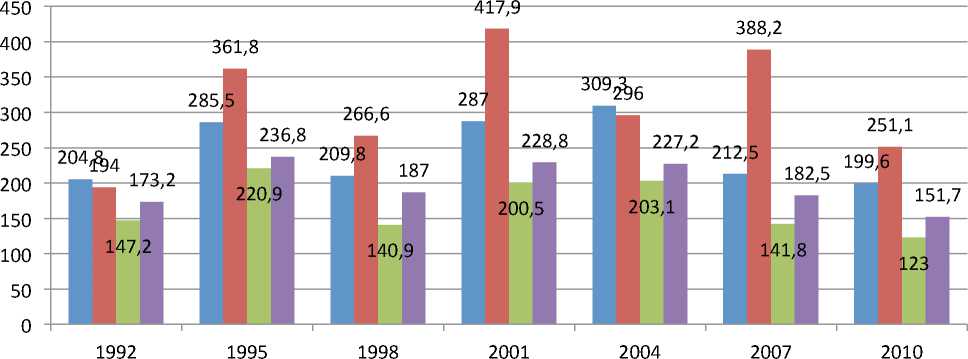
■ Архангельская область ■ Ненецкий автономный округ
-
■ Мурманская область ■ Российская Федерация
Figure 8. The number of deaths from external causes, per 100 thousand people a year in the circumpolar regions of the European North of Russia, both sexes [9]
Mortality from tumors in the regions of Northern European Russia remains stable at the turn of XX--‐XXI century (Figure 9). Arkhangelsk region, as in the case of mortality from circulatory diseases, is almost exactly the average trend indicator, while the Murmansk region and the NAO appear to be relatively well--‐off regions.

■ Архангельская область
■ Ненецкий автономный округ
-
■ Мурманская область
-
■ Российская Федерация
Figure 9. The number of deaths from neoplasms per 100 thousand people a year in the circumpolar regions of the European North of Russia, both sexes [9]
For some indigenous people, such as the Sami, who inhabit the northern parts of Norway, Sweden, Finland and the Kola Peninsula, the average level of morbidity and mortality from cancer is lower than the average population of the same countries [13].
Unfortunately, even with modern survey techniques, conducting routine inspections a sig--‐ nificant proportion of new cases of cancer in the early XXI century continues to be diagnosed at later stages (III and IV).In the Arkhangelsk region in2007, the figure was over 50% (26.4% for stage III, 26.0% for stage IV), in the Murmansk region in the same year – more than 40% (15.4 for stage III,26.9% for IV stadii) [10].
To summarize briefly the death rate in the circumpolar regions of the European North, it is worth noting that it is generally consistent average Russian tendencies. Is still a high proportion of deaths from external causes, which is still in the NAO in the rank structure in second. If the whole country, according to some researchers, the nature of mortality corresponds to that in the devel--‐ oping world, where the "no social institutions responsible for the formation and maintenance of health", in the Arctic, he testifies and social degradation [6, 11].
Marriages and divorses in the circumpolar territories of European North of Russia
Social and economic crisis of the late 1980's --‐ early 2000's led to the crisis of the family and marriage in the country. Until the late 1990s, the number of marriages per 1000 population in the circumpolar regions of the European North is constantly decreasing [4].
The implementation of the principles of the new family policy, approved by the presidential decree № 712 of 14 May 1996 "On the main directions of the state family policy", lasted until the mid--‐2000s. Since that time began to grow again and marriages population. But this process is pro--‐ vided to a large extent a high number of generations of northerners, born in late 1970--‐1980's (see above)
Divorces per 100 marriages in the arctic territories of RF in 1991--‐2009 years [9]
Table 2
|
1991 |
1993 |
1995 |
1997 |
1999 |
2001 |
2003 |
2005 |
2007 |
2009 |
|
|
RF |
46,5 |
60,0 |
61,6 |
60,3 |
58,7 |
76,8 |
72,4 |
56,0 |
53,9 |
57,6 |
|
Arkhangelsk region |
44,2 |
64,6 |
71,0 |
53,6 |
51,9 |
77,0 |
75,3 |
53,3 |
55,1 |
60,7 |
|
NAO |
38,1 |
61,5 |
61,3 |
45,1 |
48,1 |
85,5 |
76,8 |
57,1 |
50,6 |
62,5 |
|
Murmansk region |
69,8 |
83,8 |
87,5 |
76,1 |
76,1 |
93,3 |
83,9 |
77,4 |
72,0 |
78,7 |
In general, the regions of the North over the past 20 years are characterized by the average index for divorce rates (Table 2). The exception is the Murmansk region, where they are much higher. High divorces is on the one hand, a significant cause of the fertility decline, on the other --‐ leads to increase in the proportion single--‐parent families in which children grow up. This fact has a negative impact on the state of the institution of family and marriage and will undoubtedly have a lasting impact.
The disability of the population of the circumpolar regions of the European North of Russia
By definition, a disabled person --‐ is a person, who has a health problem with a persistent disorder of body functions due to disease, trauma or defects, leading to restriction of life and calls for their social protection. The exact number of people who fit this definition in a society that is not known, and only indirectly by analyzing the official statistics, it is possible to judge the scale of the phenomenon.
The number of persons newly registered disabled (disability) in the three northern regions of the country at the turn of XX--‐XXI centuries steadily increasing (Figure 10). On the national back--‐ ground in the 1990s, this growth was rather a "catch--‐up" character: the difference of a factor of 1.5--‐2 depending on the territory within the meaning of the indicator was almost completely lev--‐ eled by the early 2000's. Murmansk region again appears relatively advantaged. During the report--‐ ing period, the number of persons with disabilities was first recognized in the region, below the average of 1.5--‐2 times.
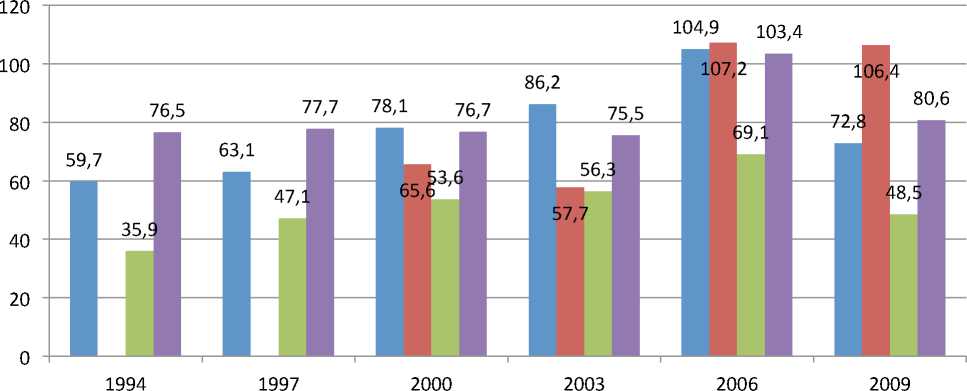
■ Архангельская область ■ Ненецкий автономный округ
■ Мурманская область ■ Российская Федерация
Figure 10. The number of persons newly registered disabled, aged 18 years and older, by 10 thousand population [9
Such variations in the value of the indicator of disability in all three regions in less than 20 years can not be explained by anything other than a change in the approach to recording and reg--‐ istration of new cases. His influence has been, and reform of the health and social expertise. Growth indicators being considered after 2003 due largely taking the Federal Law № 122 "On the monetization of benefits" that made officially register as a disabled person who had the right, but has not done so previously, due to various socio--‐economic reasons[6]. It was the fourth peak rising number of newly registered disabled in the history of this phenomenon in Russia (first celebrated in 1975, and was associated with the adoption of instructions on how to establish a causal connec--‐ tion disability of ex--‐servicemen to stay on the front number 1960--‐CH, the second --‐ in the 1985, after the decision of the Central Committee of the CPSU and the USSR Council of Ministers № 812
"On measures to improve the material conditions of life of the Great Patriotic War and the families of the dead soldiers" and the third --‐ in 1995 with the adoption of the Federal Law "On social pro--‐ tection of disabled people in the Russian Federation »№ 181--‐FZ) [7]. The relatively low rate of primary disability in the Murmansk region at the turn of XX--‐XXI centuries, due to the high propor--‐ tion of economically active young people are not interested in her desk, and generally more pros--‐ perous socio--‐economic situation in the region. In the Arkhangelsk region, the structure of the pri--‐ mary reasons of disability in 2010 is as follows (Figure 11):
-
■ Туберкулез
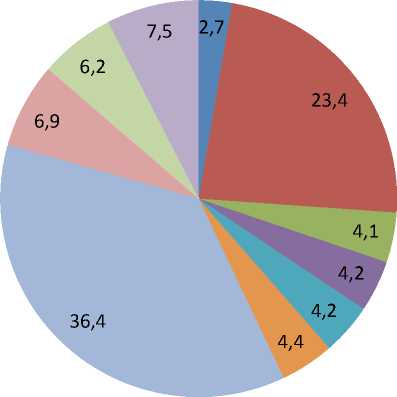
-
■ Злокачественные новообразования
-
■ Психические расстройства
-
■ Болезни нервной системы
-
■ Болезни органов зоения
-
■ Болезни органов слуха 301
-
■ Болезни органов кровообращения
Figure 11. The structure of primary disability (adults) of the Arkhangelsk region in 2010, in% [4
The first place is occupied by rank cardiovascular disease, together giving a third of new cases of disability (36.4%), second – is the malignant neoplasms (23.4%). High proportion of inju--‐ ries (6.2%) may be due to a high concentration of manufacturing companies in the region and in the whole population of unsafe behavior [7]. The North--‐West region is, according to experts, "steadily disadvantaged" in relation to disability and mortality [6]. The proportion of older persons is much higher than the critical level of 12% (that is, belongs to a group of demographically older). For the same reason, in the Arkhangelsk region, the structure of the primarily disability of adults according to the group seems illogical. It can be assumed that the form it should resemble a pyra--‐ mid whose base is a person who for the first time when the registration was set III of disability. The top of the figure should form a group of people with I (the most severe and therefore the smallest). In reality, the proportion of these groups in the overall structure of roughly equal (Figure 12). These features of the primary disability as a phenomenon suggest that it is more of a social nature, and only indirectly reflects the health of the population in the Arctic regions.
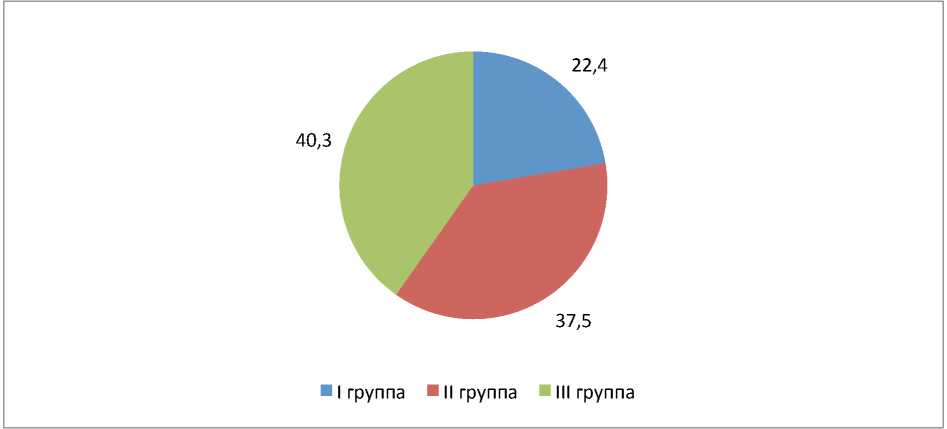
Figure 12. The structure of the primary disability of the adult population of the Arkhangelsk region in 2010 by group of disability, % [4]
Historically, Russia has a priority in the development of the resource potential of the Arctic. With the adoption of the Presidium of the USSR Central "On declaring the territory of the USSR lands and islands in the Arctic Ocean," made possible the development of its legal, which was im--‐ plemented with the arrival of explorers, builders and workers from the South. Unique demograph--‐ ic characteristics of circumpolar territories that developed at the turn of XX--‐XXI centuries, should be thoroughly studied. This qualitative analysis will help determine the effects of adverse climatic and socio--‐economic factors on health professionals and support staff who will be involved for the development of the resource potential of the Arctic in the new century, as well as to adequately modify the health care system that focuses on the specific needs of the North.
Список литературы The leading determinants of public health of the Arctic territories of the European North of Russia
- Aristov I. course on the Arctic // Rossiyskaya Gazeta. The central issue. 2010. № 5302 (223). P. 6
- The effects of global climate change on human health of the Russian Arctic. UN report on the project / ed. BA Revich. URL: http://www.ecfor.ru/ pdf.php? Id = books/revich01/oon (date of access: 28.10.2011).
- Vyazmin AM, Mordovia EA Ideas Lomonosov and Public Health in Pomerania XVIII-‐XXI centuries / AM Vyazmin, EA Mordovia, ed. prof. AL Sannikov. Arkhangelsk: Publishing House of the Northern State Medical University, 2011. 192 p.
- State report on the health status of the Arkhangelsk region in 2010 / Ministry of Health and Social Development of the Arkhangelsk region, the Office of the Federal Service for Super-‐vision of Consumer Rights Protection and Human Welfare in the Arkhangelsk region, Northern State Medical University, GOOSE "Medical Information and Analytical Center». Arkhangelsk MIATS, 2011. 180 p.
- Ivanova E., Pavlov, NB, Mikhailov Yu Trends and regional features adult health in Russia // Social aspects of public health. 18.10.2011. URL: http://vestnik.mednet.ru/content/ view/323/27/lang.ru / (date of access: 28.10.2011).
- Kasparyan JE North specifics: disability and the problem of formation of social and economic policy in the Murmansk region / North. 2007. URL: http://kolasc.net.ru/russian/sever07/ sever07_2.pdf (date of access: 28.10.2011).
- Lukashov AG, Sitkin MN, Zaroslikova LA, Varakina J., Matveev RP disability and death of the dominant, reduces the potential for life and security of the society / ed. prof. AL Sannikov. Arkhangelsk: Publishing House "Salt", 2007. 378 p.
- Problems of Health and Social Development of the Arctic zone of Russia. M.: Paulsen, 2011. 472 p.
- Statistical Yearbook. 2010: Stat.sb. / Rosstat. Moscow, 2010. 813 p.
- Cancer statistics in Russia and the CIS in 2007 / Ed. M. Davydov and EM Axel / / Bulletin of RCRC. NN Blokhin. RAMS, 2009. T. 20. Number 3 (Appendix 1). 158p
- Tikhonova GI Gorchakov TY, Kasyanchik EA demographic and health characteristics of the population of working age in Russia / / Problems of Forecasting. 2009. Number 4. Pp. 1218.
- Canadian Institute for Health Information. National Consensus Conference on Population Health Indicators. Final Report. Ottawa, Ontario, 1999. P. 5
- Hassler S., Soininen L., Sjolander P., Pukkala E. Cancer among the Sami – A review on the Norwegian, Swedish and Finnish Sami populations. International Journal of Circumpolar Health. 2008; 67 (5): pp. 421–432.
- Smith H. S., Bjerregaard P., Chan H. M., Corriveau A. Ebbesson SOE et al. Research with arctic peoples: unique research opportunities in heart, lung, blood and sleep disorders. International Journal of Circumpolar Health. 2006; 65 (1): pp. 79−90.

